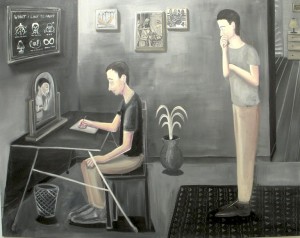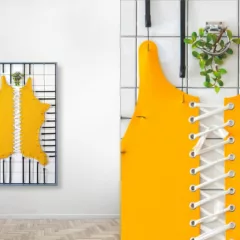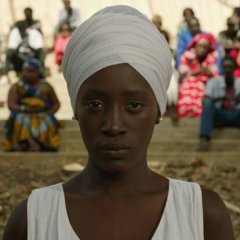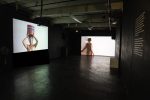[This post was scheduled to go up yesterday but couldn’t because of our hosting outage. Hope you got to see the show-yesterday was its last day.] The four featured artists at Vox Populi this month present four discrete bodies of work in each of Vox’s four gallery spaces. If there is a commonality it’s that the artists all seem to be seekers, after some truth–psychological or cosmic. That, and they all have MFAs from high powered institutions (Yale, Columbia, VCU).
Perhaps the most engaging, because of its accessible narrative edge and cartoonish style, is Guy Ben-Ari‘s mostly grisaille paintings. With a clunky awkwardness that is endearing and a surreal sensibility enhanced by the use of mirrors, windows, long corridors and the suggestion of endless interior space, the works feature characters, in pairs, (some may be twins, or friends, or because this is dream-like, a single person represented twice) who look at each other bemusedly, lovingly, anxiously, judge-ingly or lustfully.
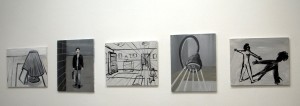
Other things are twinned too, like a table with lamp and small standing picture frame that appears, double, in one of the works. There’s no action to speak of except looking, which gives a slight sense of unease. If there is a punchline — and there isn’t — these would be pretty perfect on the cover of the New Yorker. As it is, they’re a good look and bespeak a quest to understand the nature of relationships and self.

Wilmington artist Catharine Maloney‘s series of photo-collages and photo-constructions also seem to be looking — at gender. Not only does she focus on young men who mostly seem to be wearing Star Trek-like mock turtlenecks and posing in what amount to class or team pictures, but a number of the men are quite gender ambiguous. The seeming amateurish presentation of the works makes it seem like an obsessive scrap-booker or self-taught artist put this together. I found the work intriguing, both for the obsessive, closed-circuit point of view and for the eschewing of a sophisticated presentation.
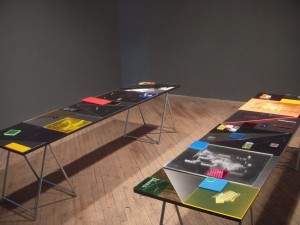
Leah Beeferman‘s two tables with colored plexiglas shapes of different sized geometric forms is situated in a gallery with black walls. The dramatic presentation and accessibility of the shapes made me immediately want to move things around on the table tops. But I was told no dice — it’s not an interactive piece. Too bad. The piece evokes two science fair tables awaiting the scientist to come and explain it all to you. There is apparently an audio component to the piece which I didn’t hear. When I went to Beeferman’s website to get some elucidation I found some delightful animations with sound, including the sound for this piece (a nice mix of what could be sounds of breathing magnified or sounds of car passing by on nearby highway and some bright percussive, almost tap-dance tapping). Clued in by the additional work on the website, it seems the artist is investigating the harmony of the spheres, and in that light, the table tops become mutable descriptions of what might be, what could be tomorrow and what might have been. Poignant, somehow.
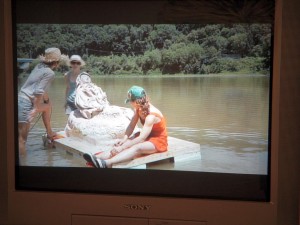
Brie Ruais‘ “Unfolding/Performing Sculpture” includes a couple of large, fired, clay starbursts on the walls; a freestanding sculpture that is appears to have the face and hands of Bernini’s St.Theresa only here she is struggling to be free of the mound of clay she’s in. Elsewhere in the room, a river of what looks like unfired clay crosses the floor ala Lynda Benglis’ rivers of latex; and a video shows a slightly different St. Theresa piece on a raft in the middle of a river with some attendants.
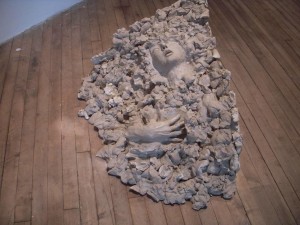
The suggestion is of some kind of Huck Finnish journey to come. The idea of transporting the clay piece downstream is highly appealing, while I don’t find the works in the room as appealing. Ruais’ work feels less like its questing for something (you don’t feel the struggle) than that it has arrived at an hypothesis and is experimenting with material and art history to perhaps knock some art history icons down a peg or two.
All in all, the art world reflected in these four rooms looks pretty much as you’d expect these days – hydra-headed and conceptual, albeit with lots of traditional materials being thrown around in a traditional manner.



